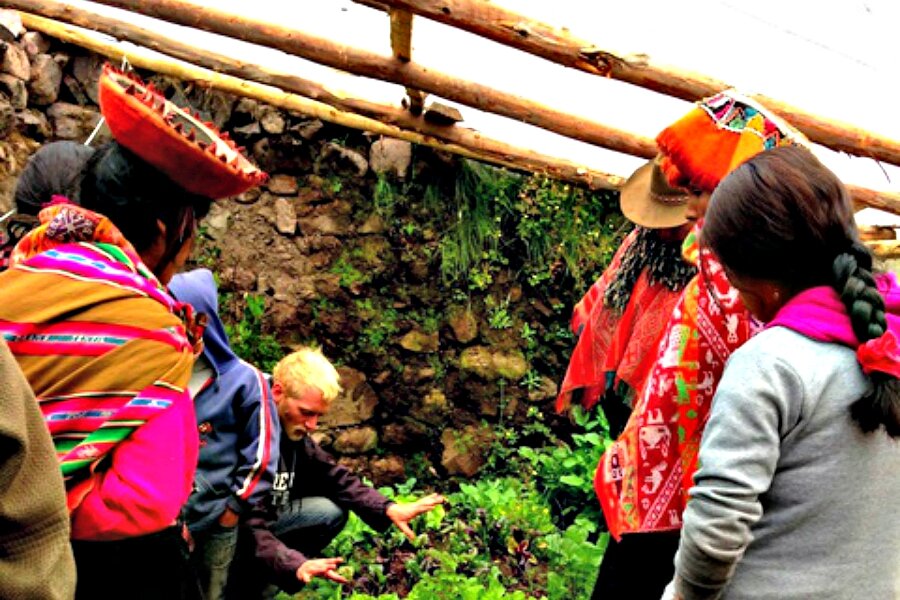Greenhouses in Peru's high Andes provide roots for innovation
Loading...
| Pompacorral, Peru
Life in the Andes mountains is hard. The climate is harsh, the air thin, and poor soil means malnutrition is a constant problem for children and adults.
But despite all odds, highland communities in Peru are proving their adaptability as they use greenhouses to test out more nutritional crops.
Venturing down the winding roads of the Andes mountains, it is not uncommon to come across “off the map” communities like Pampacorral and Maucau. For these families, it is a two hour walk to everyday conveniences, such as electricity, medical care, or even phone service.
This lack of access and connectivity is at the center of many of the challenges highland communities face today, including malnutrition.
As daylight breaks, mothers hike out to their “chakras,” or agricultural fields, where they will put in a long day’s work. With most families being subsistence farmers, they eat what they can grow. In such an intense climate, this has led to a diet heavy in potatoes and corn.
Without inter-community trade routes or access to markets where they can buy and sell fresh produce, the consumption of vegetables remains a rare occurrence.
However, The Andean Alliance for Sustainable Development (AASD), a nonprofit in the Sacred Valley of Peru, sees a brighter future for highland communities.
“Even though we start this conversation with what are the communities’ deficits, really the story is about what are their strengths,” emphasized Chris Miller, the Director of Organizational Development at AASD.
In 2012, AASD teamed up with the Middlebury Institute of International Studies at Monterey to create a project that would build upon the communities adaptability and communal work ethic. Thus “Fitotoldos” or greenhouses were proposed as the answer to growing a greater variety of crops and in turn improving families diets.
The first round of greenhouses were paired with local schools. This guaranteed that nutritious food was making its way onto kid’s plates but also that there would be a consistent institution to manage its upkeep.
Every greenhouse was constructed with stone walls, a plastic roof, and a custom-made door that gave each one its own flare.
SInce the average greenhouse was no larger than 6-by-12 meters, AASD wanted to optimize the use of the space. Owners of the greenhouses would thus be trained on how to grow produce by the biointensive standard. That meant using natural pesticides, organic fertilizers, and practicing seed saving.
“Biointensive means organic agriculture that focuses on using the resources that you already have available,” explained Miller. “So with that said, it is already in that one principle that you have introduced this idea of adaptability.”
For instance, families can concoct “Biocida,” the natural pesticide that AASD promotes. By simply combining local plants, such as cactus, garlic, and others that are sticky or smelly, farmers can reduce their pests.
AASD measured the success of their greenhouse initiative by the number of stakeholders they collaborated with. Miller noted that the participation of the local government and communities always takes the highest priority.
AASD put highland families in charge of building the stone walls and convinced the municipal government to supply the plastic roofing. Also involved were students from Monterey who conducted research on best practices for greenhouse construction, the local market for organic produce, and a vegetable cookbook to accompany the school greenhouses.
AASD provided the technical training and ongoing workshops on biointensive methods, how to save seeds, and when to harvest the new crops.
Today, five different communities have anywhere from eight to 10 school greenhouses in use. In fact, the initiative was so popular that communities started organizing the projects on their own.
“We literally had no idea that the most recent school greenhouse was being built until it was already done,” Miller said. “We wrote ourselves out of the job.”
Soon after the start of the initiative, families approached AASD about constructing greenhouses for personal use. This launched a pilot project in the town of Maucau, where 14 families constructed “fitotoldos familiares,” or family greenhouses. It wasn’t long before the neighboring community wanted the same thing.
“The hope is that family greenhouses will take off in a year or two. After four more communities we might see the same thing that happened with the school greenhouses,” said Miller. “I hope we get a call from a sixth community inviting us to check out the greenhouses they constructed on there own.””
However, this project goes far beyond the construction of greenhouses.
Anastasia, a single mom of four who lives at an altitude of 4,000 meters (13,000 feet) has taken on the role of a “positive deviant.”
“She’s innovating and using the greenhouses in ways we never even talked about or addressed,” explained Miller.
Exploring her greenhouse, AASD found that she had started growing unexpected crops, such as pineapple, and had expanded her outdoor garden to include onions and cabbage. Both were crops that were not believed to be able to be grown outside at that elevation.
Anastasia is just one of many individuals using the greenhouse as a platform to test out new agricultural crops.
What’s next for AASD and its stakeholders?
This summer, AASD and students from Monterey will use GIS technology to start mapping what people are successfully growing throughout the various micro-climates. The hope is that this could foster an exchange of agricultural practices between isolated communities that live at similar elevations.
AASD sees a future where not only knowledge is exchanged between highland communities but produce as well. While selling highland produce in the nearest city, Cusco, is a distant possibility, more realistic is a localized solution. If each highland community is growing different crops, the potential for trading between the rural communities is great.
With knowledge, adaptability, and a team effort, it seems an improved diet is on the horizon for highland communities in the Andes.
• This article originally appeared at Global Envision, a blog published by Mercy Corps.







